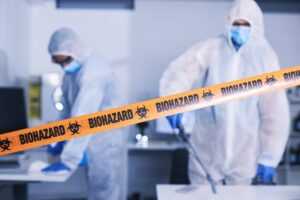We understand that sometimes life presents us with challenging situations, like those involving hazardous environments such as hoarder households or former meth labs. In these cases, it’s crucial not to take matters into your own hands, especially when it comes to dealing with the dangers of toxic mold.
There are thousands of mold species, but five categories are particularly toxic to humans: stachybotrys, penicillium, cladosporium, aspergillus, and fusarium. Today, we will delve into the world of toxic mold, discussing where it typically grows, each class of mold’s characteristics, identification methods, growth rates, and the critical reasons why you should never attempt mold cleanup without professional help. Remember, ZMB Inc. is here to assist you every step of the way.
Where Does Mold Typically Grow?
Mold is a resilient organism that can thrive in various environments. To effectively combat mold growth, it’s crucial to understand where it typically lurks within a household.
Mold in Bathrooms
Mold loves moisture, making bathrooms a prime breeding ground. Pay close attention to shower curtains, tiles, and the areas around sinks and tubs. If you notice any mold formation, it’s important to spray the areas with bleach and reach out for professional help.
Kitchen Mold
Food particles and high humidity levels in kitchens create an ideal environment for mold to flourish. Check beneath sinks, around refrigerators, and near dishwashers. Be careful not to drink unfiltered water from your sink if you suspect mold growth.
Basements
Dark and damp basements provide a perfect habitat for mold. Inspect corners, walls, and any stored items. The best way to avoid basement mold is to have your basement professionally waterproofed after a biohazard cleanup.
Attics
Inadequate ventilation in attics can lead to moisture buildup, making them susceptible to mold growth. Inspect insulation and wooden structures, and think about installing an air filtration system after all the mold has been professionally removed.
Crawl Spaces
Crawl spaces are often neglected and can harbor mold due to their damp and dark conditions. Check the underside of your home for any signs of mold growth or moisture buildup.
Toxic Mold Classes
There are 1000s of different types of mold, but today, we are here to discuss the more toxic mold classes and why mold can be a huge cause for concern in any household, especially hoarded homes or homes with obvious neglect.
Stachybotrys
Stachybotrys, commonly known as black mold, is infamous for its toxicity. It thrives in areas with excessive moisture and organic material, such as drywall and paper. Identifying Stachybotrys requires a professional assessment due to its visual similarity to other molds.
The danger lies in mycotoxins produced by Stachybotrys, which can lead to severe health issues, including respiratory problems and skin irritation.
Penicillium
Penicillium is a versatile mold often found on food, wallpaper, and damp building materials. It can appear in various colors, making identification tricky. This mold did help create the fantastic drug penicillin, which you may recognize from the name. However, if penicillium is growing in your home, it can exacerbate allergies and respiratory conditions, causing an unsafe environment for everyone.
Cladosporium
Cladosporium is commonly found outdoors but can infiltrate indoor spaces. It thrives on porous materials like wood and textiles and can trigger allergies and asthma.
Aspergillus
Aspergillus is widespread and can contaminate air conditioning systems, causing indoor air quality issues. Some Aspergillus species produce mycotoxins, posing a health risk. After a biohazard cleanup of this toxic mold, you’ll want to install an air filtration system.
Fusarium
Fusarium is often found in water-damaged buildings, including those affected by flooding. There are over 700 different species of fusarium that can cause a plethora of health conditions, including keratitis, onychomycosis (a fungal infection of the fingernails or toenails), endocarditis (inflammation of the inside lining of the heart) and sinusitis. It’s best to combat fusarium with medical-grade fungicides and proper ventilation.
The Dangers of Cleaning Toxic Mold Without Professional Help
Attempting to clean toxic mold without professional assistance can have serious consequences for your health and well-being. Without the proper medical grade equipment, your efforts may fall short of addressing your mold issues. Here’s why you should never take this risk.
Inadequate Equipment
Professionals like ZMB Inc. have specialized equipment and protective gear to safely handle mold removal. Without safety tools like medical-grade desensitizers, gloves, and protective eyewear, you risk exposure to harmful mold spores.
Incomplete Removal
DIY attempts are not recommended. Trying to clean up mold on your own may cause serious health implications and might only address surface mold, leaving hidden pockets of mold untouched. With professional help, you can remove mold from the root and remediate any risks effectively.
Health Risks
Mold exposure can lead to a range of health issues, from allergic reactions to respiratory problems and more severe conditions. Professionals mitigate these risks through proper containment and disposal.
Recurring Mold
Without addressing the underlying cause of mold growth, it will likely return. Professionals identify and rectify moisture sources to prevent recurrence and protect your home.
Contact ZMB Inc. For Mold Removal and Biohazard Cleanup in Watertown, WI
In situations involving toxic mold, biohazard cleanup isn’t just a convenience; it’s a necessity for your health and safety. At ZMB Inc., we understand the urgency of these situations and offer certified, full-service cleaning.
Our family-owned and operated company, located in Watertown, Wisconsin, specializes in commercial contract office cleaning as well as biohazard cleaning. We are fully licensed, bonded, and insured so that we can provide effective solutions for human waste, hoarded, and neglected homes.
Remember, when dealing with the five types of toxic mold—Stachybotrys, Penicillium, Cladosporium, Aspergillus, and Fusarium—seek professional assistance. Don’t compromise your well-being by attempting mold cleanup on your own. ZMB Inc. is here to provide expert biohazard cleanup services, ensuring your environment is safe and mold-free. Your safety is our top priority, and we’re just a call away from helping you breathe easier and live healthier. If you have any questions or need our assistance, please don’t hesitate to contact us. Your well-being is our mission at ZMB Inc.


